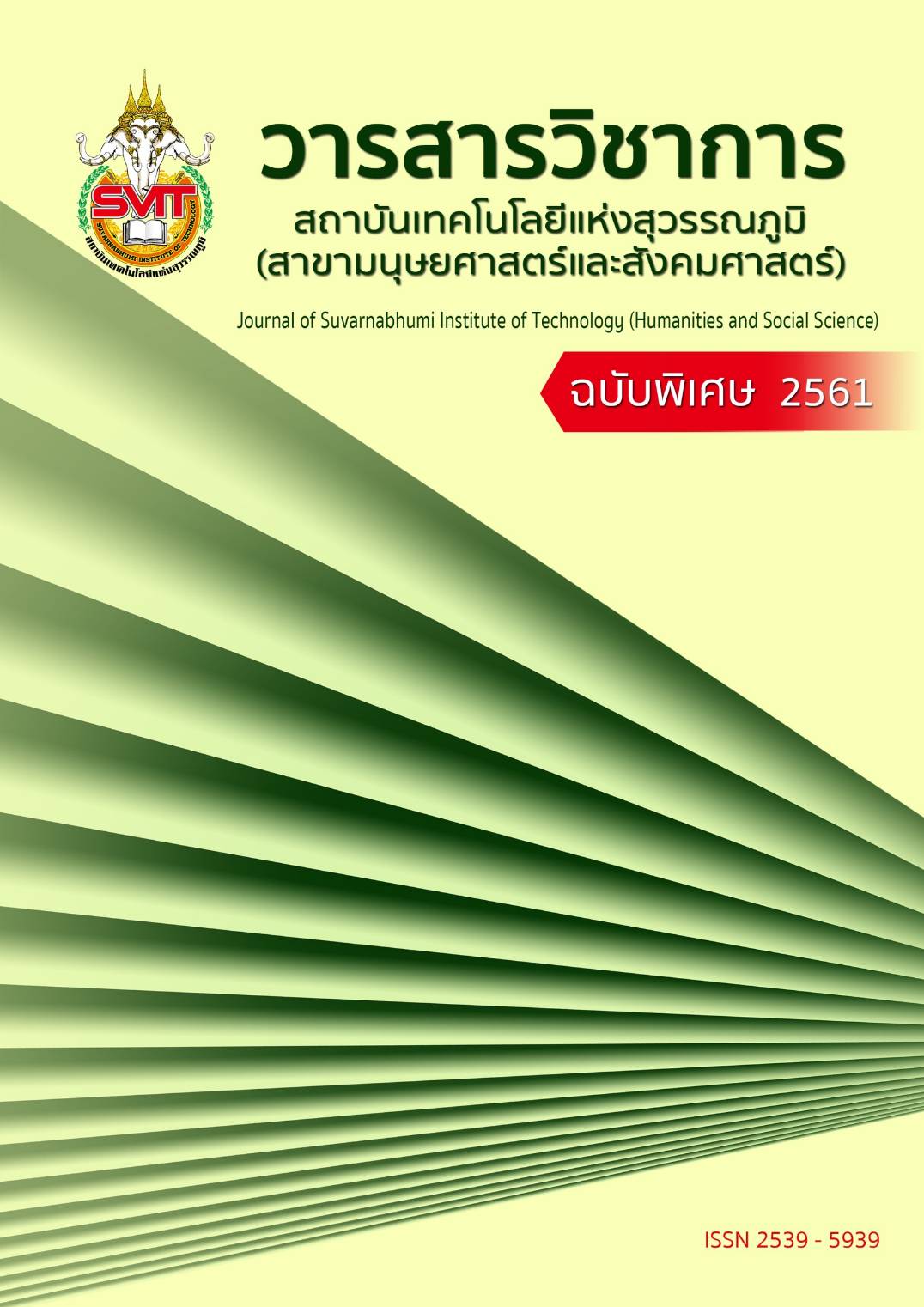COMMUNICATION ENGLISH SPEAKING PROFICIENCY BY USING COMMUNICATION ENGLISH SPEAKING ACTIVITIES OF PATHUMTHANI UNIVERSITY’S STUDENTS
Keywords:
Proficiency, Communication English Speaking, Communication English speaking ActivitiesAbstract
This purpose was to study the communication English speaking proficiency by using communication activities of Pathumthani university’s students. The sample consisted of 20 students who enrolled academic English subject (GE 1605). The tools used in the experiment and data collection were 5 learning management plans by using communication activities, pre and post communication proficiency test models with 15 weeks each 3 hours per day ,the total was 45 hours through the semester, self-assessment model on English communication speaking ,behavior observation on English communication speaking. The data was presented in the form of mean, percentage, standard deviation, and t-test.
The research revealed that the communication English speaking proficiency by using communication activities, the sample group was at the higher level than pre experiment at level of statistical significance. 01 with related the analysis from the model of behavior observation on English communication speaking and self-assessment model on English communication speaking.
References
กิตติ ประเสริฐสุข. (2555). ASEAN Insight: ทักษะภาษาอังกฤษกับอาเซียน. กรุงเทพธุรกิจ, 12. (31พฤษภาคม 2555).
ณภัทร วุฒิวงศา.2557. วารสารนักบริหาร.กรุงเทพ:มหาวิทยาลัยกรุงเทพ
ณรงค์ โพธิพฤกษานันท์. 2551. ระเบียบวิธีวิจัย. กรุงเทพฯ : ส.เอเซียเพรส (1998) จำกัด.
เยาวดี วิบูลย์ศรี. 2540. การวัดผลและการสร้างแบบสัมฤทธิ์. กรุงเทพฯ : สำนักพิมพ์แห่งจุฬาลงกรณ์มหาวิทยาลัย.
ศิริชัย กาญจนวาสี. 2550. สถิติประยุกต์สำหรับการวิจัย. กรุงเทพฯ : สำนักพิมพ์แห่งจุฬาลงกรณ์มหาวิทยาลัย
ศิริลักษณ์ อินฝาง. 2555. รายงานวิจัยในชั้นเรียน. การเตรียมความพร้อมเพื่อเข้าสู่ประชาคมอาเซียนของนักศึกษามหาวิทยาลัยเทคโนโลยีราชมงคล ล้านนา วิทยาเขตภาคพายัพ จังหวัดเชียงใหม่. คณะบริหารธุรกิจและศิลปศาสตร์.
สมเกียรติ อ่อนวิมล. (2555) “บันทึกหน้าแรกของอาเซียน” นิตยสารคู่สร้างคู่สม.ปีที่ 33 ฉบับที่ 747-749 (มิ.ย. 55) หน้า 16-17
สุวิมล ติรกานันท์. 2543. ระเบียบวิธีวิจัยทางสังคมศาสตร์: แนวทางสู่การปฏิบัติ. กรุงเทพฯ : สำนักพิมพ์แห่งจุฬาลงกรณ์มหาวิทยาลัย.
แสงเดือน ทวีสิน. 2545. จิตวิทยาการศึกษา. พิมพ์ครั้งที่ 5. กรุงเทพฯ : โรงพิมพ์ไทยเส็ง.
อเนก เพียรอนุกุลบุตร. 2527. การวัดผลและประเมินผลการศึกษา. พิมพ์ครั้งที่ 4 กรุงเทพฯ : คณะศึกษาศาสตร์ มหาวิทยาลัยรามคำแหง.
Alderfer, C.P. (1972). Existence Relatedness and Growth. New York : Free Press.
Borman, Walter C. (1993). “Role of early supervisory experience in supervisor performance,”. in Journal of Applied Psychology. 78, pp.443-449.
Brown, H. D. (2000). Principles of language learning and teaching. New Jersey: Prentice Hall.
Brown, R. A. (2007). English proficiency as a contingency of self-worth among Japanese university students. Information and Communication Studies, 37, pp.17-24.
Cong, M. (2012). [Online]. Learning motivation of college students in foreign language learning. Available from: http://minds.wisconsin.edu/handle/793/61269?. (December 20, 2013).
Gardner, R. C. (1985). Social psychology and second language learning: The role of attitudes and motivation. London: Edward Arnold.
Gardner, R. C. (1985). Social psychology and second language learning: The role ofattitudes and motivation. London: Edward Arnold.
Garrett, Henry E. (1965). Testing for teachers. New York: Van No strand Reinhold.
Gregersen, T. (2003). To err is human: A reminder to teachers of language-anxious students. Foreign Language Annuals, 36(1), pp.25-32.
Holloway, William V. (1959). State and Local Government in the United States. Administration. New York : McGraw-Hill.
Holt, J. (2001). [Online]. Motivation as a Contributing Factor in Second Language Acquisition. Available from : http://iteslj.org/Articles/Norris-Motivaties for Language teaching. New York: Cambridge University Press.
Humaida, I. A. I. (2012). Research on: Motivation to learn English among college students in Sudan. English Language Teaching, 5(8), pp.49-56.
Isakhan, B. and Stockwell, S (co-eds). (2011). The Secret History of Democracy. London : Palgrave Macmillan.
Jacobsen, T. (1943, July). “Primitive Democracy,” in Ancient Mesopotamia Journal of Near Eastern Studies. 2 (3) : pp.159-72
Jump, N. (1978). Psychometric Theory. (2nd ed.). New York : McGraw–Hill.
Kagan, S. (1995). Cooperative learning & weescience. San Clemento: Kagan Cooperative Learning.
Knowles, Malcom . (1997). The Adult Learner : A Neglected Species. 3th ed., Houston: Gulf.
Krejcie, R.V. and Morgan, D.W.(1970). Determining Sample Size for Research Activities. Educational and Psychological Measurement. 30(3), pp. 607-610.
Kuiper, A., & Tan, C. P. (2007). Communication in a foreign environment: The speaking of English by international students at a New Zealand university. Proceedings of the Association for Business Communication. City University of Hong Kong.
Liu, M. (2007). “Chinese students’ motivation to learn English at the tertiary level.” in Asian EFL Journal, 9(1), pp.126-146.
Matsuda, S., & Gobel, P. (2004). Anxiety and predictors of performance in the foreign language classroom. System, 32, pp.21-36.
Mills, N., Pajares, F., & Herron, C. (2007). “Self-efficacy of college intermediate French students:Relation to achievement and motivation.” in Language Learning, 57(3), pp.417-442.
Morrow, K. (1981). Principle of Communicative and Methodology in Communication in the Classroom, Applications and Methods for Communicative Approach. London: Longman.
McClelland, D.C. (1961). The Achieving Society. Princeton, NJ : Van Nostrand.
Melanesia Historical and Geographical. (1950). The Solomon Islands and the New Hebrides. Southern Cross n1, London.
Newmyer, Jacqueline. (2005). “Present from the start : John Adams and America.” in Oxonian Review of Books. Vol 4 issue 2.
Nussbaum, Martha. (2000). Women and human development: the capabilities approach. Boston : Cambridge University Press.
Oxford, R. L. (1990). Language learning strategies: What every teacher should know. New York: Newbury House Publisher.
Thomas E. Robinson. (1997). [Online]. Communication apprehension and the basic public speaking course: a national survey of in-class treatment techniques. Available from : http:www.asian-efl-journal.com (December 15, 2007).
Walker, C. O., Greene, B. A., & Mansell, R. A. (2006). “Identification with academics, intrinsic/extrinsic motivation, and self-efficacy as predictors of cognitive engagement.” in Learning and Individual Differences, Vol.16, pp.1-12.
Wasley, P.A. (1991). Teachers who lead: The rhetoric of reform and the realities of practice. New York : Teachers College Press.
Wong, S. L. (2005). “Language learning strategies and language self-efficacy: Investigating the relationship in Malaysia.” in RELC Journal, 36(3), pp.245-269.
Downloads
Published
Issue
Section
License
บทความที่ได้รับการตีพิมพ์เป็นลิขสิทธิ์ของวารสารวิชาการ สถาบันเทคโนโลยีแห่งสุวรรณภูมิ
ข้อความที่ปรากฏในบทความแต่ละเรื่องในวารสารวิชาการเล่มนี้เป็นความคิดเห็นส่วนตัวของผู้เขียนแต่ละท่านไม่เกี่ยวข้องกับสถาบันเทคโนโลยีแห่งสุวรรณภูมิ และคณาจารย์ท่านอื่นๆในสถาบันฯ แต่อย่างใด ความรับผิดชอบองค์ประกอบทั้งหมดของบทความแต่ละเรื่องเป็นของผู้เขียนแต่ละท่าน หากมีความผิดพลาดใดๆ ผู้เขียนแต่ละท่านจะรับผิดชอบบทความของตนเองแต่ผู้เดียว





